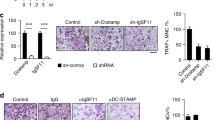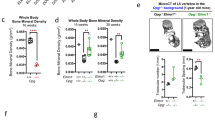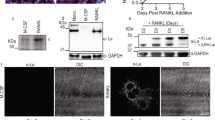Abstract
Morphogenesis and remodeling of bone involve synthesis of bone matrix by osteoblasts and coordinate resorption of bone by osteoclasts. Defective bone remodeling caused by altered osteoclast activity underlies a multitude of osteopenic disorders. Receptor activator of NF-κB (RANK) and its ligand RANKL have been identified as essential factors involved in osteoclast development and bone remodeling, but their mechanism and interacting factors have not been fully characterized. Here we report that the molecular adapter Grb-2-associated binder-2 (Gab2) associates with RANK and mediates RANK-induced activation of NF-κB, Akt and Jnk. Inactivation of the gene encoding Gab2 in mice results in osteopetrosis and decreased bone resorption as a result of defective osteoclast differentiation. We also show that Gab2 has a crucial role in the differentiation of human progenitor cells into osteoclasts. We have thus identified a new, key regulatory scaffold molecule, Gab2, that controls select RANK signaling pathways and is essential for osteoclastogenesis and bone homeostasis.
This is a preview of subscription content, access via your institution
Access options
Subscribe to this journal
Receive 12 print issues and online access
$209.00 per year
only $17.42 per issue
Buy this article
- Purchase on Springer Link
- Instant access to full article PDF
Prices may be subject to local taxes which are calculated during checkout





Similar content being viewed by others
References
Baron, R. Molecular mechanisms of bone resorption: therapeutic implications. Rev. Rhum. Engl. Ed. 63, 633–638 (1996).
Suda, T. et al. Modulation of osteoclast differentiation and function by the new members of the tumor necrosis factor receptor and ligand families. Endocr. Rev. 20, 345–357 (1999).
Karsenty, G. & Wagner, E.F. Reaching a genetic and molecular understanding of skeletal development. Dev. Cell 2, 389–406 (2002).
Boyle, W.J., Simonet, W.S. & Lacey, D.L. Osteoclast differentiation and activation. Nature 423, 337–342 (2003).
Kong, Y.Y. et al. OPGL is a key regulator of osteoclastogenesis, lymphocyte development and lymph-node organogenesis. Nature 397, 315–323 (1999).
Gu, H. & Neel, B.G. The 'Gab' in signal transduction. Trends Cell. Biol. 13, 122–130 (2003).
Hibi, M. & Hirano, T. Gab-family adapter molecules in signal transduction of cytokine and growth factor receptors, and T and B cell antigen receptors. Leuk. Lymphoma 37, 299–307 (2000).
Liu, Y. & Rohrschneider, L.R. The gift of Gab. FEBS Lett. 515, 1–7 (2002).
Holgado-Madruga, M., Emlet, D.R., Moscatello, D.K., Godwin, A.K. & Wong, A.J. A Grb2-associated docking protein in EGF- and insulin-receptor signalling. Nature 379, 560–564 (1996).
Sachs, M. et al. Essential role of Gab1 for signaling by the c-Met receptor in vivo. J. Cell. Biol. 150, 1375–1384 (2000).
Itoh, M. et al. Role of Gab1 in heart, placenta, and skin development and growth factor- and cytokine-induced extracellular signal-regulated kinase mitogen-activated protein kinase activation. Mol. Cell. Biol. 20, 3695–3704 (2000).
Seiffert, M. et al. Gab3-deficient mice exhibit normal development and hematopoiesis and are immunocompetent. Mol. Cell. Biol. 23, 2415–2424 (2003).
Gu, H. et al. Essential role for Gab2 in the allergic response. Nature 412, 186–190 (2001).
Nishida, K. et al. Requirement of Gab2 for mast cell development and KitL/c-Kit signaling. Blood 99, 1866–1869 (2002).
Gonzalez-Espinosa, C. et al. Preferential signaling and induction of allergy-promoting lymphokines upon weak stimulation of the high affinity IgE receptor on mast cells. J. Exp. Med. 197, 1453–1465 (2003).
Gu, H., Botelho, R.J., Yu, M., Grinstein, S. & Neel, B.G. Critical role for scaffolding adapter Gab2 in Fc gamma R-mediated phagocytosis. J. Cell. Biol. 161, 1151–1161 (2003).
Matsuzaki, K. et al. Osteoclast differentiation factor (ODF) induces osteoclast-like cell formation in human peripheral blood mononuclear cell cultures. Biochem. Biophys. Res. Commun. 246, 199–204 (1998).
Yamasaki, S. et al. Docking protein Gab2 is phosphorylated by ZAP-70 and negatively regulates T cell receptor signaling by recruitment of inhibitory molecules. J. Biol. Chem. 276, 45175–45183 (2001).
Koga, T. et al. Costimulatory signals mediated by the ITAM motif cooperate with RANKL for bone homeostasis. Nature 428, 758–763 (2004).
Takayanagi, H. et al. Induction and activation of the transcription factor NFATc1 (NFAT2) integrate RANKL signaling in terminal differentiation of osteoclasts. Dev. Cell 3, 889–901 (2002).
Teitelbaum, S.L. & Ross, F.P. Genetic regulation of osteoclast development and function. Nat. Rev. Genet. 4, 638–649 (2003).
Lomaga, M.A. et al. TRAF6 deficiency results in osteopetrosis and defective interleukin-1, CD40, and LPS signaling. Genes Dev. 13, 1015–1024 (1999).
Theill, L.E., Boyle, W.J. & Penninger, J.M. RANK-L and RANK: T cells, bone loss, and mammalian evolution. Annu. Rev. Immunol. 20, 795–823 (2002).
Li, J. et al. RANK is the intrinsic hematopoietic cell surface receptor that controls osteoclastogenesis and regulation of bone mass and calcium metabolism. Proc. Natl. Acad. Sci. USA 97, 1566–1571 (2000).
David, J.P., Sabapathy, K., Hoffmann, O., Idarraga, M.H. & Wagner, E.F. Jnk1 modulates osteoclastogenesis through both c-Jun phosphorylation-dependent and -independent mechanisms. J. Cell Sci. 115, 4317–4325 (2002).
Nakamura, I. et al. Wortmannin, a specific inhibitor of phosphatidylinositol-3 kinase, blocks osteoclastic bone resorption. FEBS Lett. 361, 79–84 (1995).
Takeshita, S. et al. SHIP-deficient mice are severely osteoporotic due to increased numbers of hyper-resorptive osteoclasts. Nat. Med. 8, 943–949 (2002).
Iotsova, V. et al. Osteopetrosis in mice lacking NF-kappaB1 and NF-kappaB2. Nat. Med. 3, 1285–1289 (1997).
Acknowledgements
We thank L. Barra, N. Joza and E. Wagner for discussion and reagents; K. Paiha and P. Steinlein for assistance in microscopic analysis; A. Bichl and K. Flahndorfer for maintenance of mice; J. Wada and Y. Nakashima for genotype determinations; S. Hirota and T. Hirota for technical assistance; and Y. Kobayashi, N. Udagma, N. Takahashi, H. Yasuda and H. Takayanagi for technical suggestions. T.W. is supported by the H15th fellowship of the Japan Society for the Promotion of Science. This work was supported by the Institute for Molecular Biotechnology of the Austrian Academy of Sciences and the Jubilaeumsfonds of the Austrian National Bank.
Author information
Authors and Affiliations
Corresponding authors
Ethics declarations
Competing interests
The authors declare no competing financial interests.
Supplementary information
Supplementary Fig. 1
Gene targeting of mouse Gab2. (PDF 1707 kb)
Supplementary Fig. 2
Normal osteoblast function. (PDF 6118 kb)
Supplementary Fig. 3
Impaired osteoclastogenesis but normal RANK expression. (PDF 7299 kb)
Supplementary Fig. 4
RANKL/RANK-mediated signaling in preosteoclasts. (PDF 2800 kb)
Supplementary Table 1
Micro-CT analysis in Gab2-deficient mouse femurs (PDF 613 kb)
Rights and permissions
About this article
Cite this article
Wada, T., Nakashima, T., Oliveira-dos-Santos, A. et al. The molecular scaffold Gab2 is a crucial component of RANK signaling and osteoclastogenesis. Nat Med 11, 394–399 (2005). https://doi.org/10.1038/nm1203
Received:
Accepted:
Published:
Issue Date:
DOI: https://doi.org/10.1038/nm1203
This article is cited by
-
Mast cell deficiency prevents BCR::ABL1 induced splenomegaly and cytokine elevation in a CML mouse model
Leukemia (2023)
-
Gab2 deficiency prevents Flt3-ITD driven acute myeloid leukemia in vivo
Leukemia (2022)
-
Gab2 deficiency suppresses high-fat diet-induced obesity by reducing adipose tissue inflammation and increasing brown adipose function in mice
Cell Death & Disease (2021)
-
A Panel-Based Sequencing Analysis of Patients with Paget’s Disease of Bone Suggests Enrichment of Rare Genetic Variation in regulators of NF-κB Signaling and Supports the Importance of the 7q33 Locus
Calcified Tissue International (2021)
-
Spi-C positively regulates RANKL-mediated osteoclast differentiation and function
Experimental & Molecular Medicine (2020)



